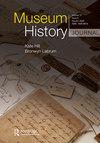A museum or a sanctuary of memory? The impact of a non-existent city museum in Russian Warsaw (1905–1915)
IF 0.2
Q3 HISTORY
引用次数: 0
Abstract
ABSTRACT Severely repressed after the anti-Russian uprising, Warsaw entered a period of forced centralisation in the Empire after 1881, with all elements of Polish history and traditions erased form school textbooks and public life. This article describes the urban revival at the end of the nineteenth century, which also included the rehabilitation of Warsaw's central historic space. The revolution of 1905 led to the possibility of establishing institutions which could be in charge of monuments and of disseminating knowledge about the urban past. The Old Town became quite fashionable among the Polish intelligentsia, whose wealthier representatives bought homes, including one that was turned into the city museum. In 1912 a large exhibition of Warsaw's past displayed pieces from the final decades of the eighteenth century. The museum, its locality and the historic exhibits were proof of the historic consciousness of the groups involved in its establishment, their national ideal, as well as the mission of propagating knowledge among the less conscious urban population. This process was part of the cultural and political modernisation of the urban society, which developed alongside other important issues, including discussions about the re-establishment of self-government in the city and abandoning its fortress status.是博物馆还是记忆的圣地?俄国华沙不存在的城市博物馆的影响(1905-1915)
摘要反俄起义后,华沙受到严重镇压,1881年后,华沙进入了帝国的强制中央集权时期,波兰历史和传统的所有元素都从学校课本和公共生活中抹去。本文描述了19世纪末的城市复兴,其中还包括华沙中心历史空间的修复。1905年的革命导致了建立机构的可能性,这些机构可以负责纪念碑和传播有关城市历史的知识。老城在波兰知识分子中变得相当时尚,他们的富裕代表购买了房屋,包括一栋被改建为城市博物馆的房屋。1912年,华沙的一个大型展览展出了18世纪最后几十年的作品。博物馆、其所在地和历史展品证明了参与博物馆建立的群体的历史意识、他们的民族理想,以及在意识较低的城市人口中传播知识的使命。这一过程是城市社会文化和政治现代化的一部分,与其他重要问题一起发展,包括关于在城市重新建立自治政府和放弃堡垒地位的讨论。
本文章由计算机程序翻译,如有差异,请以英文原文为准。
求助全文
约1分钟内获得全文
求助全文

 求助内容:
求助内容: 应助结果提醒方式:
应助结果提醒方式:


